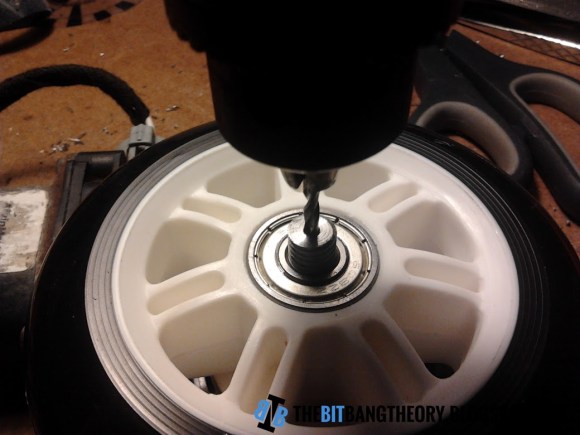
We agree with [Mário Saleiro] that the motors from a car’s power windows make for a fantastic high-torque solution to your next project. If you have a you-pick junkyard in your town they’ll be dirt cheap after you put in a bit of time to find and removing the parts from the yard. But you’ll probably want to add a few extra steps to get them ready, and he’s done a great job of documenting how he augmented them with wheels and rotary encoders.
One aspect of the project which really struck home with us was his machine-shop-101 style tricks to mate the axle of the motor with the wheel. He has a process which ensures you will find the exact center of a cylinder as you work. This starts by lining up a bench vice on his drill press. He then inserts a drill bit upside down in the drill chuck, lowers it and clamps the vice on the bit. After loosening the chuck he ends up with the bit pointing up at the exact center of the chuck. Next he chucks up a piece of threaded rod, drilling a perfectly centered hole by lowering it into the drill bit while the drill press is rotating. The image above shows him using this machined part as a guide to continue the hole into the motor’s axle. Click through the link above to learn the rest of the tricks he uses.















Nice work! Definitely going to try this!
Any posts on actually using them to install power windows on a manual window car? xD
Mighty Car Mods had a video on manual to electric window conversion. However, they use a kit specific to this situation.
http://www.youtube.com/watch?v=Q1AxO6Bt-kk
lol, i had the same idea for my old car’s power window motor for a RC power wheels. nice!
Vise, not Vice.. using words incorrectly is a vice.
http://en.wikipedia.org/wiki/Vise
Except in British English where it is a vice to improperly use a vice.
You mean when you really need to put a squeeze on it?
….Being a grammer/spellin nazi…also a vice?
Nice project,
He has better——
Everyone should check out the rest of his site as well
One thing to keep in mind is that these are low duty cycle motors, so don’t expect them to run continuously for very long.
With a low duty PWM signal they may be fine for continuous uses. eg I have ran washer pumps continuously for a good 30minutes on about 10% PWM duty- They overheat/burn out within minutes on 100% duty. Wouldn’t be surprised if it’s the plastic cases causing problems with heat. Perhaps drilling a hole near each end of the motor case and passing non conductive fluid through the motor much like “water cooling” for PCs could increase duty.
This is true, they’re surprisingly resilient when you modulate their use with PWM signals. Windshield wiper motors are also great, and they’re designed for more continuous use at load. You might be able to make a cooling sleeve/jacket around the case and run a coolant through that without having to compromise the motor’s case, but I’ve never tried that before (yet). :)
EUR 25 for two old, used motors you have to disassemble a car to obtain seems quite steep when these parts sometimes are cheaply had when the automotive companies dissolve their spare part stock (check junk/bulk resellers).
With newer models, sometimes these motors also have integrated electronics and sensors (PIC, relay, hall effect quadrature encoder).
Most of the time the motor shafts seem to require some work to connect, however.
I quite agree 25 euro is too much to pay for used motors and go through the work of modifying. How about these? http://www.goldmine-elec-products.com/prodinfo.asp?number=G18238
Indeed you can get 2 new powerfull 1.8 degree stepper motors for 30euro nowadays -> saves you the rotary encoder too ;). Still nice work especially if you have some motors lying around. But indeed visiting a junk yard you should get them cheaper if you just say any window motor will do …
I found with motors like these you can manage without a shaft encoder by counting the commutation hash transmitted up the cable.
This was with car seat motors which drive a thread and have very little inertia so it’s easy to infer what direction the shaft is travelling, but the commutation noise is very regular and surprisingly easy to detect even if the motor has built in RF suppression.
cool idea.
Not my idea though sadly. I found it on the web once, but have lost the link.
Here’s something similar: http://www.precisionmicrodrives.com/tech-blog/2011/06/08/using-dc-motor-commutation-spikes-to-measure-motor-speed-rpm
We use these all the time in FIRST Robotics…
I’m a little late to the party but the seat motors usually are better because they have built-in encoders and there’s more of them in a car (4-6 per seat) so they sell cheaper.
Regarding the commutation noise, at least BMW detects absolute position of the seat by using this, I think it’s already integrated in the motor and all the communication with the rest of the car is digital (CAN). In the luxury cars they might have switched already to BLDP.
Might prove useful info for someone not looking to reinvent the wheel.
Other than that, the quoted 30E/motor is a bit on the high side, a little shopping around the scrapping yards will be able to get you 10 motors for that price.
Nice trick, if you don’t have a lathe, that is. The other method I’ve seen is to use a sacrificial block of wood with a kerf cut almost all the way through the center. Center the kerf in the drill press, clamp it down to the table, and then drill a hole slightly larger than the object you want to drill. Place the object to be drilled in the hole, clamp the kerf closed, and then you can finally drill a perfectly centered hole.
Much easier with a metal lathe though.